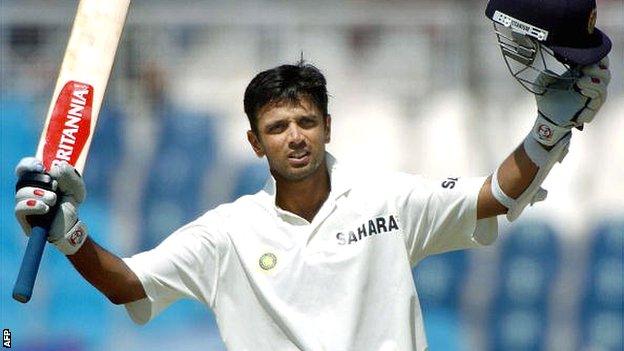Rahul Dravid: The Great Wall of India
- Published

Rahul Dravid, who has retired from international cricket at the age of 39, was the cornerstone of a stellar India middle order.
Though seemingly always in the shadow of the world's leading run-scorer Sachin Tendulkar, his career has been played out like one of his trademark innings - watchfully and with complete dedication to the team cause.
Dravid, Sourav Ganguly - the first of the Indian 'Fab Four' to retire - Tendulkar and VVS Laxman, both of whom are still playing, have appeared in 599 Tests between them, scoring a combined total of 44,751 runs.
Only Tendulkar of the four has a higher overall Test average than Dravid's 52.
Dravid and Ganguly both made their debuts on the tour of England in 1996.
Wristy, shot-making players from the subcontinent have frequently been criticised for failing to adapt to difficult English conditions, where seam and swing are prevalent, but it was to be one of Dravid's most successful venues.
On two separate visits to England he hit three centuries, a feat achieved by only one other batsman - a certain Sir Donald Bradman - and averaged 68 over four trips.
Not that he confined his biggest runs to England. He was the first player to score centuries in each of the 10 Test-playing nations and reached three figures in each of his 17 years in Test cricket, bar the first and last.
He shared in a world record 19 Test century partnerships with Tendulkar, became the first number three to score 10,000 Test runs and is the only outfielder to have taken more than 200 catches.
Dravid's nickname 'The Wall' was devised because of innings such as the 270 he made in more than 12 hours against Pakistan in 2004, the longest by an Indian batsman in Test history.
But he had already proved there was more to his armoury with a 50 in just 22 balls against New Zealand at Hyderabad in a one-day international in 2003.
On India's wretched tour of England in 2011,, external when they were beset by injuries and relinquished the world number one Test ranking after a 4-0 whitewash, Dravid showed that he could still perform on the big stage with 602 runs in the four Tests and was named India's man of the series.
He opened the batting when injuries hit the side, carrying his bat for 146 not out at The Oval, and topped India's averages.
At the age of 38 he also agreed to make his first and only Twenty20 international appearance, striking three successive sixes in his 31.
Dravid scored five Test centuries in 2011, a figure he had only equalled once before, in 2002.
The tour of Australia in December and January also finished in a 4-0 whitewash for India and this time Dravid was less prolific, passing 50 only once, in the first innings of the first Test, and returning a modest average of 24.
He was also bowled six times in the eight innings during the series, gaining an unwanted new Test record of being bowled more times than any other player.
With typical selflessness he has chosen to bow out and allow a new generation its chance.
The task facing India now is how to find another like him.
- Published9 March 2012
- Attribution
- Published9 March 2012
- Attribution
- Published9 March 2012
- Attribution
- Published16 December 2011